Social recruiting is the process of finding new employees by advertising on and reaching out through social media, personal networks, and job search websites. It is increasingly a strategy that companies of all sizes employ, as it helps employers connect quickly and easily with potential applicants and candidates.
This article covers the benefits of social media recruiting, as well as how to implement a social recruiting strategy (from identifying the appropriate platforms to evaluating your success) and best practices for getting the most out of your efforts.
Benefits of Using Social Media to Recruit
With their broad reach, social media platforms allow you to identify and connect with skilled professionals in any given field and find qualified candidates, including passive ones, interested in your job postings. Social recruiting can also save you time and money.
Implementing a Social Recruiting Strategy
Keep in mind that there are a few things to consider when using social media for recruiting purposes. Make sure your postings are relevant to the target audience and include helpful information, such as salary ranges and job requirements.
Follow the steps below to learn how to reach your audience using social media recruiting.
Social media platforms are not one-size-fits-all. Finding the right people is about knowing where your audience lies and connecting with them.
In addition to creating a brand presence to attract candidates, many companies use social media as a critical piece of their recruitment strategy to learn about who they’re hiring. Be clear about what you’re trying to learn about your candidate. Each social media platform offers a different way to promote your open positions and different insights about your audience.
It is likely that your potential candidates are already using these platforms and will leverage them to determine if their values align with those of potential employers. Once you build your following and connect with the right people, you can post your jobs and add links that direct potential candidates to your listings on a job board or company career page.
Facebook is a social network connecting people to friends and family and allowing users to follow companies and join groups. Although Facebook Jobs is no longer active, you can post your job openings directly to your Facebook business page and potentially reach a monthly audience of 3 billion active users. It also gives you a glimpse into how candidates present themselves to strangers, friends, and family.
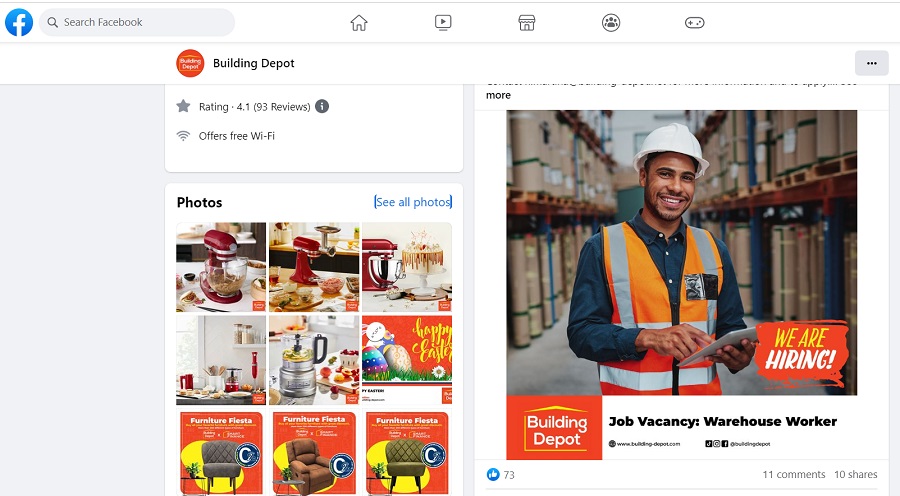
Highlight that you are hiring with a large “We Are Hiring” graphic on your Facebook page.
Posting your open positions on your business page within Facebook is free, and applicants can apply through your career page. You can also paste a tracking link to your applicant tracking system (ATS) directly on Facebook, allowing you to track candidates and schedule interviews.
Instagram and Pinterest are social networking platforms that many companies use to display their culture and initiatives through photos. Instagram boasts 2.5 billion monthly active users, and Pinterest has over 518 million users monthly. The sites can also help you understand where potential candidates spend their free time or what they might be passionate about.
Posting open positions is not as easy on these platforms, as you are limited to just posting photos and not allowed to post links to other sites. You can, however, boost your employer brand on these platforms, making users want to visit your website to learn more.

Get creative with your job postings on Instagram (MediaCom USA lists “We’re Hiring” next to their name) and include a way for candidates to apply.
LinkedIn, a social network focusing on making business connections, can help you learn more about a candidate’s professional experience. It provides an excellent foundation for finding candidates by creating a company presence through an official company profile, job postings, and relevant company updates. Any updates to your company profile and interactions you have can reach a monthly audience of 310 million potential job candidates.
You can post jobs for free on LinkedIn. Additionally, you can promote your job (for a fee), which will ensure a top position in the search results. Candidates can apply directly on LinkedIn or be directed to your career page or job board.
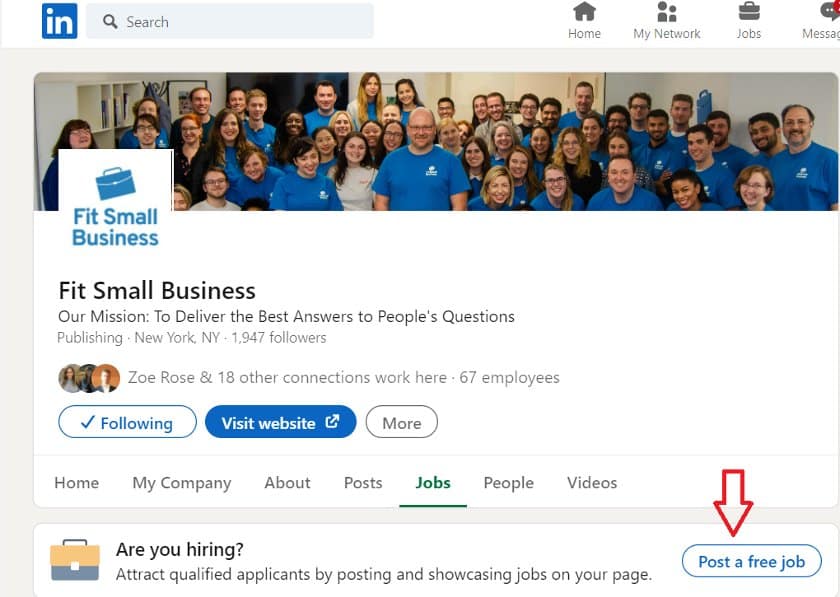
Post a job for free on LinkedIn.
TikTok is a social network that allows you to post up to 3-minute videos and have live interactions with its 1.6 billion active monthly users. While TikTok’s business side is mainly for advertising products and services, it can be used to promote company brand awareness and job opportunities.
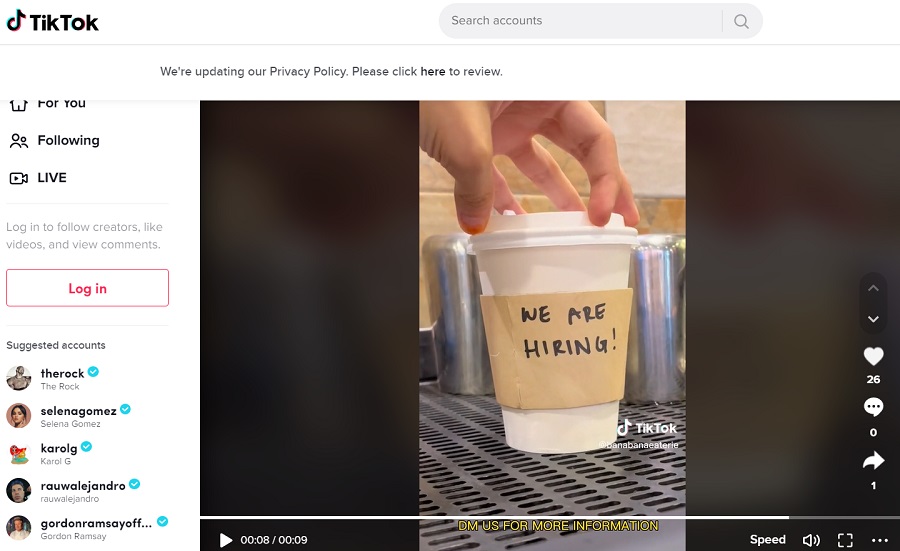
You can upload quick (10-30 second) videos on TikTok to show followers that you are hiring.
X (formerly Twitter) is a social networking platform where users post and interact with messages, known as tweets. It has 619 million active users monthly, making it an ideal platform for sharing your job postings. While you cannot post jobs directly on X, you can post a link to your company career page or job board and highlight your opening in a tweet.
Engaging candidates on X may also assist in educating you more about their interests and what they value.
Users are limited to 280 characters in their posts, so you will want to get straight to the point regarding your open positions. Additionally, X uses hashtags (#) to help you find and interact with tweets—a great way to ensure candidates find your post.
Hashtag: A word or phrase preceded by a hash sign (#) and used on social media websites and applications to identify messages on a specific topic.
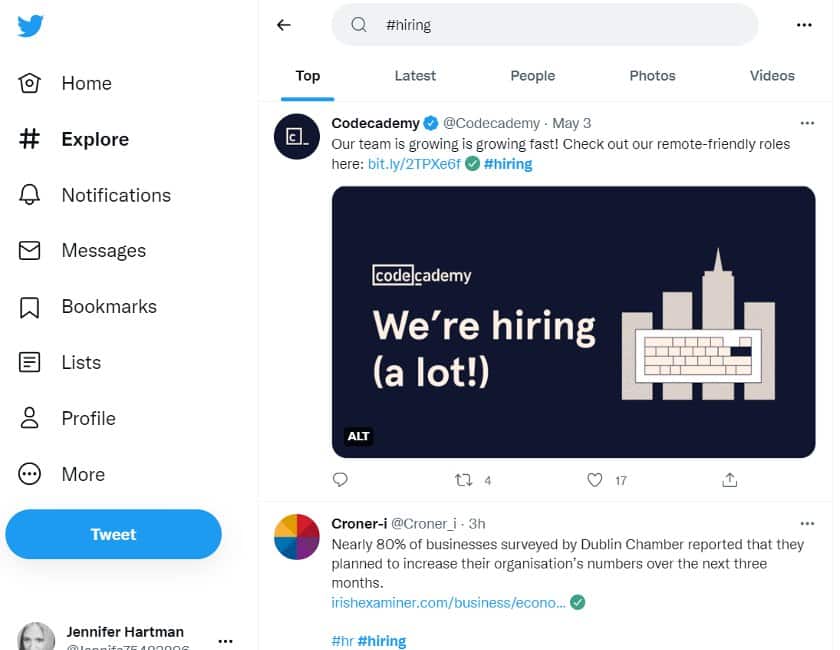
Use #hiring on your job posts so potential candidates can find your open positions.
Did You Know?
About 33% of X users have a college degree. This means that job seekers who use X may already have the education and skills required to fill a particular job role in your company.
While YouTube may not seem like a traditional social media network, it is an excellent platform for promoting your brand. It has 2.9 billion active users monthly and will allow you to post videos—informational, how-to, and more, including job opportunities. You can build a strong brand and improve candidate experience with several well-rounded videos that highlight your company culture.
Jobs are not posted directly to YouTube; however, you can promote your open positions in your videos. And, you are not limited to a certain length, allowing you to say everything you need to about your company and the position.
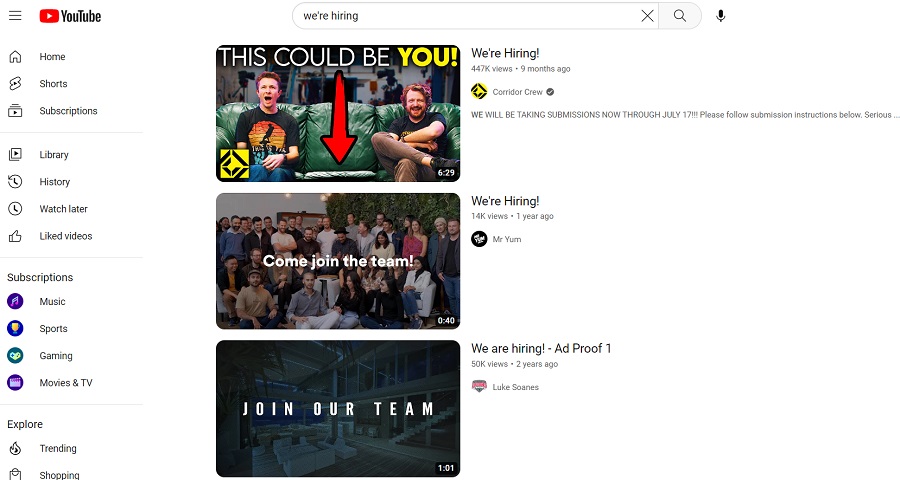
Get creative when advertising your open positions on YouTube.
It’s important to keep in mind the risk of bias in the recruitment process. If you allow information gleaned from these social media channels about an applicant’s age, marital status, or other factors to inappropriately affect a hiring decision, you could invite a lawsuit. Proactively vet your recruitment strategy to avoid this risk.
With billions of people using social media worldwide, there is a lot of competition for your potential candidate’s attention. It is of utmost importance that employers create captivating online content to catch and hold the awareness of their audience.
Establish your company’s online reputation by displaying your company brand and values (and, ideally, how your company lives these values). Top talent wants a straight line between their own ethics and the beliefs of the organization they work for. Creating a place to showcase your company’s values will provide an opportunity to start that emotional connection by displaying what is important to your company beyond revenue.
Did You Know?
According to Qualtrics, 56% of candidates will not even consider working for a company that doesn’t share their values.
Use photos, video streaming, and blog posts to tell your company’s story in your own voice. There is no better way to give your audience direct access to your company than displaying photos and using video to spotlight events, speakers, employees, and a day in your work life. Remember to add links to your career page and mention that you’re hiring in the caption.
Social media tends to move quickly, and with all of the real-time interaction, it is easy to forget to follow up on leads or direct messages. If you are contacting passive candidates via direct message, check frequently for responses and keep the conversation flowing. The ultimate goal is to transform a direct message into an actual conversation—which is difficult to achieve if there are lags in replies.
The intention behind using social media for recruiting is to leverage your network. Should you receive a referral from someone in your network, be sure to follow up promptly—your company’s reputation relies upon it.
All social media initiatives should be backed by HR metrics. LinkedIn, for instance, offers Talent Insights, which are aggregated and standardized data points retrieved from member profiles. These data points shed light on metrics around topics such as talent availability, demographic breakdowns within any given industry, how many people applied for a position, skills held by your applicants, and possible average salaries for similar roles.
Regardless of which social media network you decide to use, it’s essential to collect data and determine the reach and impact of using a particular network, thus leading to understanding your return on investment (ROI).
Social Media Recruiting Best Practices
Keep an open mind when it comes to using social media for recruitment. There is no one right way to do things, so be flexible and experiment with different methods and platforms if you aren’t seeing the results you want. Additionally, be careful not to overuse social media for recruitment purposes as you don’t want your followers to become overwhelmed by notifications or messages.
Get Your Company #Trending
If you are interested in creating a viral buzz about your organization to attract talent, it’s important to understand which hashtags to use to increase traffic. As we mentioned earlier, hashtags are keywords or phrases that help categorize your content for social media users. When you use a hashtag, the platform aggregates all social media content with the same hashtag, so it’s easy to find content in one place.
Twitter is well-known for the use of hashtags, but most other social networks use them as well. By using hashtags before keywords, candidates will be able to find content about your company, even perhaps without looking for it directly. Many job seekers follow hashtags such as #resume, #jobopening, and #HR. Be sure to use relevant hashtags and even hashtag specific positions (i.e., #SoftwareEngineer) to attract a more curated audience.
Find Passive Candidates
Social media is a great way to attract candidates that may already be interested in working for your company. However, it is also a very effective tool for gathering information about passive candidates, those potential hires who may not be actively looking for a change, but can be won over with the right push.
LinkedIn, in particular, is a widely used social media network for passive recruiting. Its products, Recruiter Lite and Recruiter Corporate, help you source and contact candidates. The platform provides access to candidate profiles (which serve as resumes) and advanced search filters to assist with finding candidates with the right skill and level of experience for any given position.
On Facebook, on the other hand, employers can share positive events that are happening at the company, which can help to promote the brand. Employers can also post open positions and, in turn, ask employees to repost the positions on their pages. Because news on social media travels so quickly, there are a plethora of opportunities to attract candidates who may otherwise be outside the reach of your immediate circle.
Remember, passive job seekers are generally happy with their current job and will not be willing to leap into another job without serious consideration. This is why building relationships with this particular target group is important. The first step to building a relationship is to reach out with a personalized message, so be sure to use the correct name and mention relevant experience when reaching out to potential candidates.
Stay Engaged
It’s hard to maintain relationships with people you don’t hear from—so imagine how easy it is to lose connection with a company that hardly posts. Candidates need regular reminders of why your company is interesting and why they would be excited to join the team. Make it a habit to post multiple times a week and be approachable and friendly (a little humor never hurts either, if it is appropriate for the brand).
Consider interacting with your online audience and use this as an opportunity to comment on and “like” work that you admire and respond to supportive comments about your company. Your business’s reputation rides heavily on how you interact online.
Use Groups & Sub-networks to Find Your Next Hire
Some social media sites, like Facebook and LinkedIn, offer users the ability to sign up to networks or groups devoted to particular business sectors. Over two-thirds (68%) of job seekers feel that signing up to these groups is important to progress in their own careers and cite these reasons for joining:
- Gaining intelligence on the market
- Leveraging an ideal platform for discussing trends
- Interacting with like-minded professionals
- Job-hunting opportunities
- Ascertaining the identities of key players in the market
Companies should use these same groups to find engaged job seekers to interact with and to provide relevant market data, trends, and curated information about open positions. Developing value-driven relationships is an excellent way to make an impact on potential candidates.
Manage Your Reputation
While it’s easy to get caught up in creating a social media recruiting strategy focused on what your company is doing, it’s as important to protect your reputation by getting ahead of what your company is not doing.
Employees tend to use social media websites like Yelp and Glassdoor as a way to honestly share feedback on how the organization is managed, what benefits are provided, and the efficacy of senior leadership. Potential candidates often use these sites to make judgments about a company’s culture and will determine whether or not they wish to entertain an opportunity from your organization based on these reviews.
A recent survey shows that 56% of candidates would share a positive applicant experience on social media, both on their personal and professional networks.
In an ideal world, only positive reviews would exist for your company. If you do, however, find that you’ve received a less-than-stellar rating, don’t respond defensively online. This often escalates matters—and while it may be entertaining to read, top candidates will not want to join a company where there is drama online.
Instead, consider responding by thanking the reviewer and extending an invitation to resolve the matter offline. Your goal is to always take the high road and maintain a baseline of respect—your future employees might be watching, after all.
Bottom Line
Social media recruiting is a fantastic way to reach your target audience and create a curated experience that feels hands-on and authentic. To maximize social recruiting for your company, however, it’s important to determine which networks will provide the most value and which audiences you’d like to address. Creating exciting content, following up on any leads, and interacting with a friendly tone will ensure that you will grab the attention of your audience.